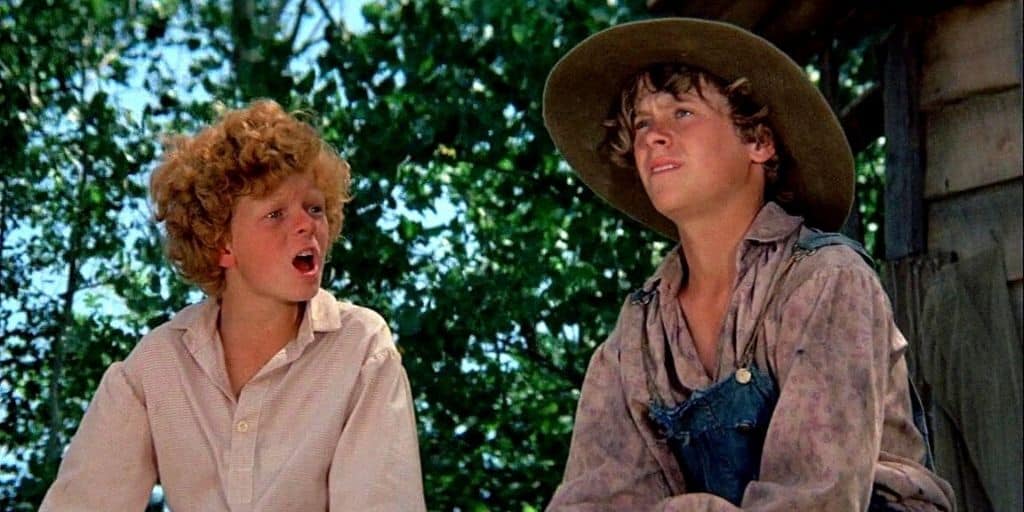Read about the key Tom Sawyer themes
Boyhood and growing up
This novel is to a great extent an exploration of boyhood. It is Mark Twain’s first novel and there is a sense in which in writing it he was reliving his own childhood in a small town in southern America in the middle of the nineteenth century.
Tom Sawyer is a rebel. The adults who surround him are constantly concerned by his rule-breaking, fighting, ducking out of chores, truanting, telling lies, stealing treats from his Aunt Polly’s closet, and so on. All that is presented with humour and affection. There is not a trace of judgment in Twain’s portrayal of him. In fact, Tom’s escapades are a delight to read. His gang’s activities are often satirical mirror images of the town’s adult behaviour.
More daring and imaginative than the other boys, Tom is admired by them. They all misbehave, but never in such a bold manner as Tom, which makes him their leader. His friend, and rival in wildness, is the unsupervised boy, Huckleberry Finn. He is every boy’s dream, envied because he is free to do as he likes without adult censure. The boys of the town bond through rebellion, and those who don’t conform, such as Tom’s half brother, Sid, are isolated.
Adults who don’t conform are also isolated. The mirror image is the expectation of good behaviour among them, so the criminals, Injun Joe and Muff Potter are outcasts, excluded from society.
The theme of boyhood includes the mapping of Tom’s journey from rebellious boy to responsible citizen through the process of maturing. Tom is an intelligent and sensitive boy and he realizes that his actions can have serious consequences. He is driven to make several moral decisions like testifying against Injun Joe and protecting Becky Thatcher from being whipped by their teacher by taking the blame for ripping the book.
The other model of boyhood does not lead to an acceptance of society. Huck Finn also matures. He performs the most heroic act in the novel when he saves the Widow Douglas’ life. However, even after he wins the approval of the adults he is not drawn into the kind of behaviour that would make him completely accepted. He does not conform, by going to church, developing table manners, and so on, preferring to live on the outskirts of society instead.
As the novel ends we see the two boys presenting as two different models of looming adulthood. In spite of that, they continue to bond through their firm friendship. Such friendship is a characteristic of boyhood that Mark Twain endorses as enduring wisdom – a friendship that will be with them throughout their lives.
Adult hypocrisy
The novel is set in small-town America. It is a close-knit society where everyone knows everyone else. The townsfolk see themselves as law-abiding, Godfearing, church-going, stable families who raise their children with discipline, with the aim of turning out responsible adults.
Almost everyone goes to church on Sundays and all accept a common set of moral values. The town judge is the most respected figure and he administers the law with rectitude and fairness. School attendance is compulsory and education consists of reinforcing the inflexible rules that guard the town’s social values. It is a model of what a good society should be.
However, the town is full of children and they can muddy the water. The novel focuses on them, particularly the boys, who are led in boyhood rebellious behaviour by the rebel-in-chief, Tom Sawyer. Their activities frequently show gaps in the adults’ logic, and reveal a degree of hypocrisy, as they often say one thing and do another. Aunt Polly intends harsh punishments for Tom’s behaviour but is unable to follow them through to harsh action. Tom is sometimes punished for not doing as he agreed to do, but her hypocrisy in not carrying out her threats is not, and in that sense she is being hypocritical. In spite of that, she remains a moral authority.
When Tom joins the Cadets of Temperance he does that, not because of any belief or understanding of the cause of temperance, but because of the effect that the fancy sash he will be allowed to wear will affect his standing among the other kids. The author suggests that the adult members of the Temperance group are similarly motivated – more impressed by the actual membership, with its insignia, than by the cause itself.
The author extends his satire to the hypocrisy in 19th century America in general. For example, Aunt Polly is typical of small-town American women in her belief in quack medicines. That is a reflection of Tom’s and Huck’s belief in black magic but, whereas there is no authoritative affirmation of that, there are medical ‘authorities’ in support of the efficacy of quack medicines, who are themselves charlatans.
The town’s adults fail to follow through on their word in response to Tom’s various transgressions. In running away to Jackson’s Island, getting lost in the cave, and tracking down Injun Joe’s treasure, Tom and his friends break several serious rules, but in every case, the villagers don’t punish them. Mark Twain is suggesting that one can’t condemn the community for their hypocrisy in desiring the children’s safety. He is affirming the ultimate goodness of community, which is not a simple matter of the strict policing of children. Hypocrisy is not always such a bad thing and can be forgiven when it results in the good.
Adventure
Adventure, exploration, and discovery are central themes in the American experience. It is at the core of The Adventures of Tom Sawyer.
Tom is an adventurer, an explorer, and a thrill-seeker, driven by his imagination and sense of nobility. The novel’s title is a nod towards the popular emerging literary genre – the adventure novel – and reveals the author’s intention of commenting on it. He makes repeated references to other tales of high adventure like “Injun Joe’s cup stands first in the list of the cavern’s marvels; even “Aladdin’s Palace” cannot rival it.”
Moreover, the sarcastic tone of the novel presents a postmodern self-consciousness – the sense that the author is telling a story that is aware that it is a story being told. Tom’s adventures subsequently become a commentary on adventure stories. There is an echo of Don Quixote in that Tom’s imagination like Don Quixote’s plays the central role in his adventures. It is a comment on the role of imagination in the premise of adventure. Tom is connected with Don Quixote with his romantic swashbuckling. Like the knight of La Mancha Tom is self-made, formed by his reading of romantic adventurers.
Race
Any novel set in in the middle of the 1800s in a southern state in America cannot avoid the question of race. Mark Twain does his best to avoid the elephant in the room – slavery – in this, his first novel, but takes it full-on in a later novel, The Adventures of Huckleberry Finn.
However, one of the main characters in Tom Sawyer is the half-Native American murderer, Injun Joe. He is subject to the usual stereotypes about Native Americans but Mark Twain positions himself as a commentator on that by making Injun Joe the one who promotes that stereotype himself.
There are brief mentions of slaves in the novel but because the protagonists are children and the plot is focused on their adventures, all we see regarding slaves is a conventional view of slavery as it affects them at an age before prejudice has a chance to set in. The novel does not depict any episodes that might reveal any adult attitudes to slavery.
That’s take on the key Tom Sawyer themes. Make sense? Any questions? Let us know in the comments section below!

Tom Sawyer characters in the 1973 movie




Can you highlight central storylines also of the adventures of Tom Sawyer